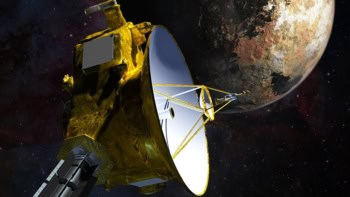
The surprisingly high concentrations of helium-3 found at volcanic hotspots could be evidence for the existence of a rare helium-bearing chemical compound deep within the Earth. That is the conclusion of an international team of physicists who have calculated that crystalline FeO2He could exist at temperatures and pressures found at the boundary between the Earth’s core and mantle. They have also shown that the material has acoustic properties associated with parts of this boundary.
While helium is the second most abundant element in the universe, it is very rare on Earth. Indeed, the first evidence of helium was spotted in light from the Sun (where the element abounds) in 1868, nearly three decades before it was detected on Earth.
Nearly all the helium on Earth is helium-4 created by the ongoing radioactive decay of uranium and thorium deep underground. Some becomes trapped in the same places as natural gas – and this helium can be harvested for a range of uses from party balloons to cooling the superconducting magnets of magnetic-resonance imaging systems.
Volcanic hot spots
Helium-3 accounts for about 0.0001% of helium on Earth and physicists believe that most of it is primordial – meaning that the isotope was created by nuclear fusion in ancient stars before being incorporated into the Earth as it formed 4.5 billion years ago. Being a noble gas, helium does not easily form chemical compounds – and therefore any primordial helium-3 within the Earth should have floated off into space long ago. However, relatively high concentrations of helium-3 found at volcanic hot spots suggests that the isotope is somehow stored deep within the Earth and is released when helium-bearing rock is pushed up towards the surface.
While helium is not known to chemically bind with other elements, it can become incorporated within some crystalline materials at high pressures. Until now, however, none of these materials was expected to occur deep within the Earth.
In this latest work, Yanming Ma of Jilin University, Changfeng Chen of the University of Nevada and colleagues in the US, China and the UK used a search algorithm to look for iron- or magnesium-based materials that have lower energies when helium is incorporated into their crystal structures. These two elements were chosen because of their abundance inside the Earth.
Stable under pressure
No magnesium compounds were identified, but the algorithm did suggest that FeO2He is stable at 3000–5000 K and 135–300 GPa. These temperatures and pressures are expected to occur at the boundary between Earth’s core and mantle.
This could be a significant finding because geophysicists already suspect that FeO2 and its hydrides (FeO2Hx) exist in “ultralow velocity zones” (ULVZs) that lie directly above the core–mantle boundary. ULVZs are hundreds of kilometres in diameter and tens of kilometres thick and were discovered because of their effect on seismic waves travelling through the Earth.
To see if FeO2He has a similar effect on seismic waves, the team calculated how sound waves propagate through the crystalline material. They confirmed that its acoustic properties are consistent with seismic data related to ULVZs.
Writing in Physical Review Letters, the team describes FeO2He as the “only helium-bearing compound viable at pertinent geophysical conditions, thus providing vital physics mechanisms and materials insights for elucidating the enigmatic helium reservoir in deep Earth”.



